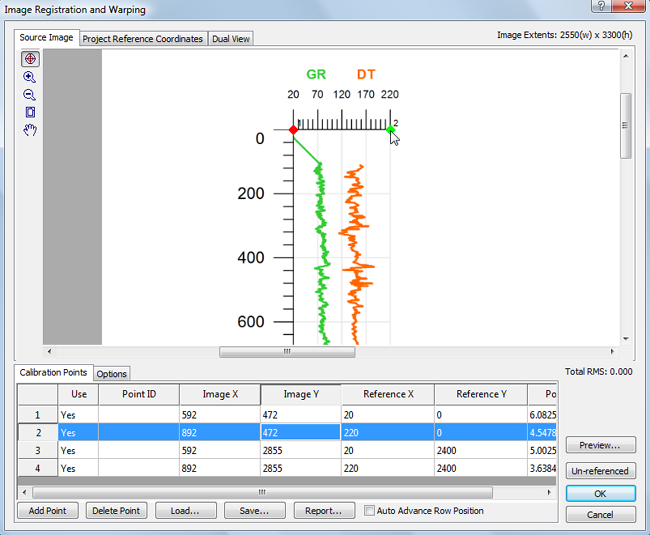
In addition to being able to export a single-line .LAS file, Didger 5 has the ability to export a multi-line .LAS file. Since Didger only accepts one calibration at a time, this is useful if you are either digitizing a single log or if all your logs use the same scale. The single exported .LAS file would contain the data for all digitized lines, be it one line or multiple lines.
However, in many cases the different logs use different scales. In this case, you may want to digitize and export multiple lines that have different scales into one .LAS file. This can be done in Didger with a few modifications.
Instructions for both cases are described in detail below:
Go to File | Import, select the image file and click the Open button.
In the Image Registration and Warping dialog, calibrate the image according to the scale of the log(s), and click the OK button.

The Image Registration and Warping dialog is displayed.
3. Digitize all the log lines as polylines. If the log is a different color than the background grid lines, or if there aren't any background grid lines, using the Image | Vectorize Image command may be very useful to automatically digitize the log. If you use the Vectorize Image command, you may need to use the Tools | Edit Boundaries | Connect Polylines command on the vectorized objects so that you have a single polyline. You may also need to use Tools | Reshape to edit the log polyline slightly.
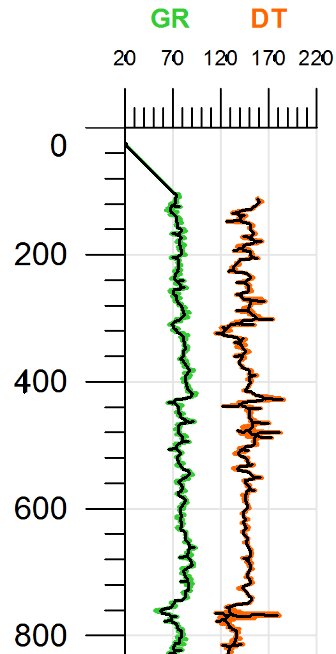
The log image was imported into Didger and calibrated.
Both the green GR and orange DT logs
were digitized as black polylines.
4. Enter the Curve Type, Curve Units, and/or Curve Description as the polyline IDs.

Enter the curve type, units, and description as the polyline IDs.
5. Go to File | Export. In the Export dialog, change the Save as type to LAS - Log ASCII Format (*.las), enter a File name, specify the Save in location, and click the Save button.
6. In the LAS Export dialog, click the Curve Info tab to open the curve info properties. Set the Start Depth, Ending Depth, and Step values. If you entered the curve settings as an ID for the polyline, be sure to specify the correct ID fields in the Curve Settings section.
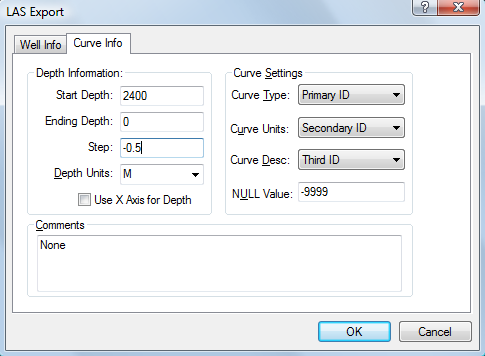
Set the Start Depth, Ending Depth, and Step values for the LAS file.
Also set the Curve Settings to the appropriate ID, if entered.
7. In the LAS Export dialog, click the Well Info tab to open the well info properties. Add any additional information about the well.
8. Click the OK button. The single .LAS file is exported with all the digitized data.
Method 2: Digitizing multiple lines using different scales and combining into one .LAS file
Part 1: Digitize and export the multiple curves from Didger
1. Go to File | Import, select the image file and click the Open button.
2. In the Image Registration and Warping dialog, calibrate the image according to the first log you want to work with and click the OK button.

Import the log image and calibrate it in the Image Registration and Warping dialog
according to the first log you want to digitize.
3. Digitize all the log lines as polylines. If the log is a different color than the background grid lines, or if there aren't any background grid lines, using the Image | Vectorize Image command may be very useful to automatically digitize the log. If you use the Vectorize Image command, you may need to use the Tools | Edit Boundaries | Connect Polylines command on the vectorized objects so that you have a single polyline. You may also need to use Tools | Reshape to edit the log polyline slightly.
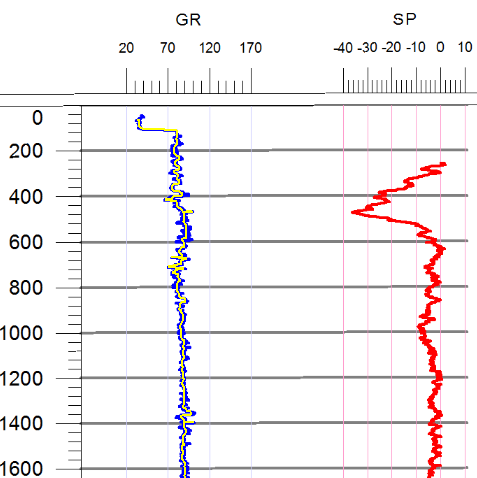
The log image was imported into Didger and calibrated according to the
Gamma Ray (GR) log. The blue GR log was then digitized as a yellow polyline.
4. Enter the Curve Type, Curve Units, and/or Curve Description as the polyline IDs.

Enter the curve type, units, and description as the polyline IDs.
5. Go to File | Export. In the Export dialog, change the Save as type to LAS - Log ASCII Format (*.las), enter a File name, specify the Save in location, and click the Save button.
6. In the LAS Export dialog, click the Curve Info tab to open the curve info properties. Set the Start Depth, Ending Depth, and Step values. If you entered the curve settings as an ID for the polyline, be sure to specify the correct ID fields in the Curve Settings section.
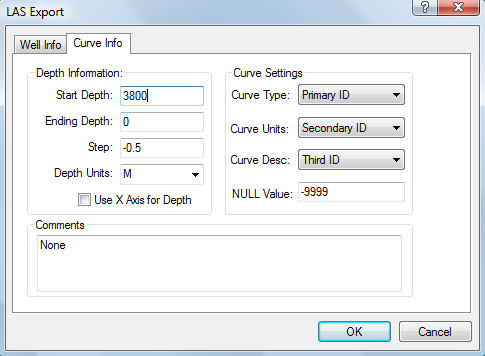
Set the Start Depth, Ending Depth, and Step values for the LAS file.
Also set the Curve Settings to the appropriate ID, if entered.
7. In the LAS Export dialog, click the Well Info tab to open the well info properties. Add any additional information about the well.
8. Click the OK button. The .LAS file is exported with all the digitized data.
9. Delete the polyline you digitized in Part 1 Step 3.
10. Select the image and go to Image | Image Registration and Warping.
11. Recalibrate the image according to the next log you want to digitize.
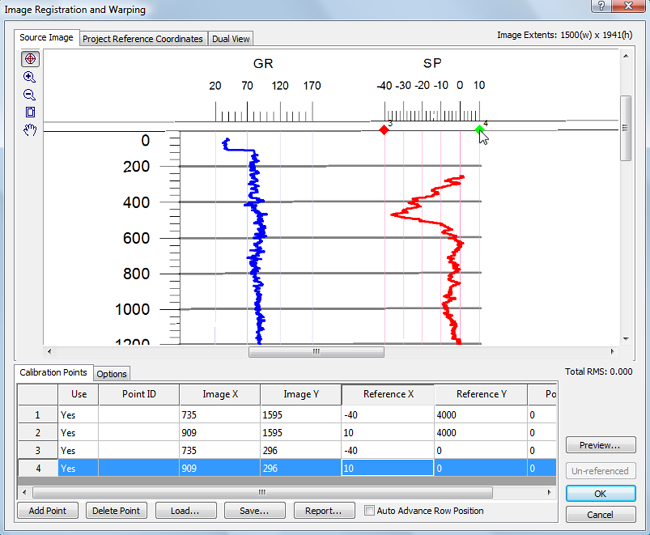
Delete the first polyline and go to Image | Image Registration and Warping.
Recalibrate the image according to the next log.
12. Digitize the next log line as a polyline and enter the Curve Type, Curve Units, and/or Curve Description as the polyline IDs.
13. Go to File | Export. In the Export dialog, change the Save as type to LAS - Log ASCII Format (*.las), enter a File name, specify the Save in location, and click the Save button.
14. In the LAS Export dialog, click the Curve Info tab to open the curve info properties. Set the Start Depth, Ending Depth, and Step values. If you entered the curve settings as an ID for the polyline, be sure to specify the correct ID fields in the Curve Settings section.
15. In the LAS Export dialog, click the Well Info tab to open the well info properties. Add any additional information about the well.
16. Click the OK button. The .LAS file is exported with all the digitized data.
17. Repeat Part 1: Steps 9-16 for all logs in the image. You will end up with multiple .LAS files, one for each log you digitized.
Part 2: Combine all the LAS files into a single LAS file
1. Open Excel. Select File | Open and select the first .LAS file. In the Text Import Wizard - Step 2 of 3 dialog, select Space as the Delimiters. Click the Finish button.
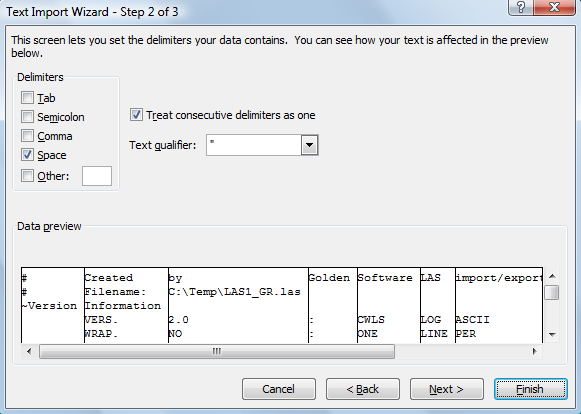
Open the .LAS file in Excel, selecting Delimited file type, choosing Space delimiters, and clicking Finish.
2. Once the file opens, under the ~CURVE section, you will see a DEPTH row and then a row of information for your first curve. Insert a new blank row after that first curve for each additional curve you have.

Insert a blank row after the first curve in the ~CURVE section
for each curve you have.
3. Open the .LAS file for the second curve in Excel, choosing Space delimited.
4. In this second .LAS file, select the curve info from the ~CURVE section and copy it using Edit | Copy or CTRL + C on your keyboard.

Copy the curve information from the second .LAS file.
5. Paste the curve information from the second .LAS file into the first blank line in the ~CURVE section of the first .LAS file using Edit | Paste or CTRL + V on your keyboard.
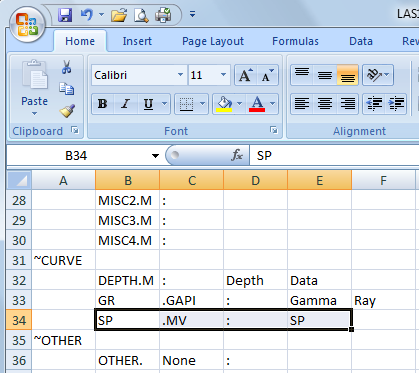
Paste the curve information from the second .LAS file
into the first blank line in the first .LAS file.
6. In the second .LAS file, select all the information from Column C under the ~ASCII section and go to Edit | Copy or press the CTRL + C key on your keyboard.
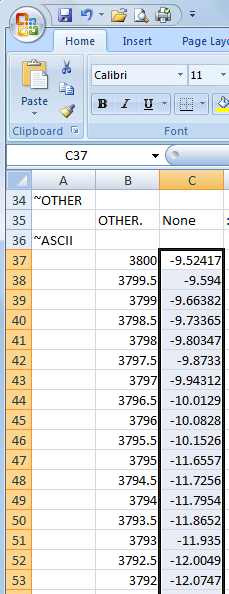
Select and copy the data information in
Column C of the ~ASCII section from
the second .LAS file.
7. In the first .LAS file, select the first cell in Column D under the ~ASCII section and go to Edit | Paste or CTRL + V on your keyboard.
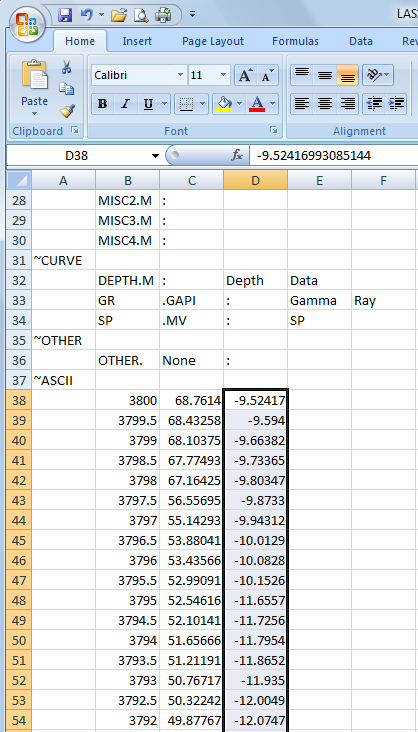
Paste the information from the second .LAS file into Column D of the
~ASCII section of the first .LAS file.
8. Repeat Part 2: Steps 3-7 for all .LAS files you have, so that all information is copied into the first file.
9. Go to File | Save As.
10. In the Save As dialog, enter the entire file name in quotes (ie: "MultipleLogs.las"), change the Save as type to Text (Tab delimited)(*txt), and click the Save button.
11. Now this is a combined .LAS file you can use in other programs.
See Also